To connect deeply with nature through mindful travel journaling, start by calming your mind with breathing exercises and finding a quiet spot. Engage your senses fully: notice sights, sounds, textures, and scents around you. Use prompts like sketching or writing about your feelings and observations, and incorporate mindfulness practices such as gratitude and slow breathing. Regular reflection helps transform fleeting moments into meaningful memories. Keep exploring these techniques to cultivate a richer, more intentional connection with the natural world.
Key Takeaways
- Start with meditative breathing and find a quiet space to cultivate presence before journaling.
- Engage your senses actively by observing sights, sounds, textures, and scents during your nature walk.
- Use prompts like poetry, sketches, or reflection questions to deepen your connection and expressive journaling.
- Incorporate mindfulness practices such as gratitude and deliberate breathing to enhance awareness during writing.
- Reflect on sensory details and moments of awe afterward to strengthen your bond with nature and foster wonder.
Preparing Your Mind and Space for Reflective Travel
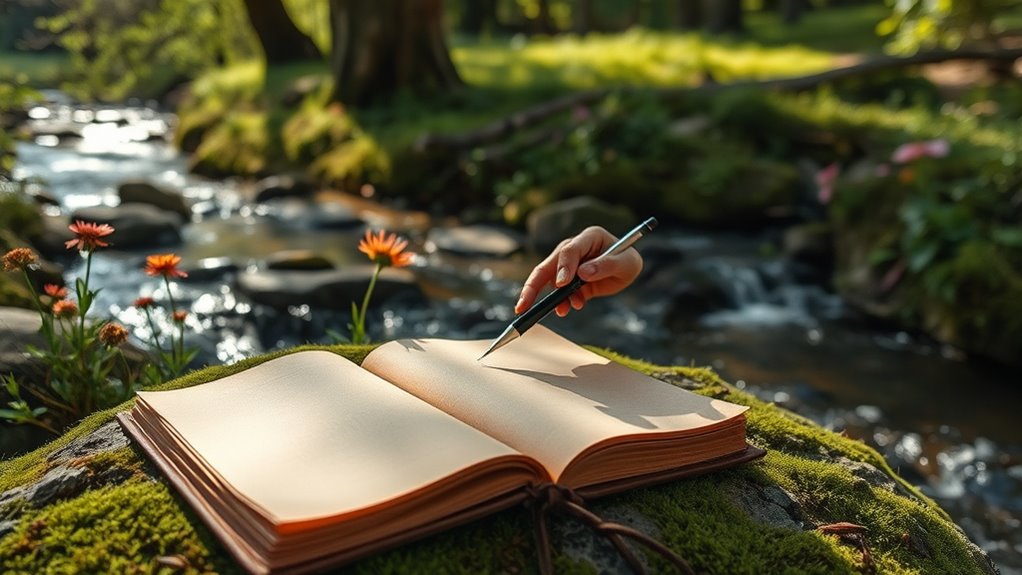
Before setting out on your journey, take a moment to prepare both your mind and your space for reflection. Begin with some meditative breathing to center yourself, inhaling slowly through your nose, then exhaling fully. This helps calm your mind and enhances your awareness. Find a quiet spot where you can sit comfortably, free from distractions. Practice mindful observation by noticing your surroundings—the colors, sounds, and textures—without judgment. This intentional focus sharpens your senses, making your experience more meaningful. Clearing your mental space allows you to be fully present during your walk. When you approach nature with a calm, attentive mindset, your journaling becomes more authentic and insightful, deepening your connection to the environment and yourself.
Techniques for Engaging Your Senses During Nature Walks
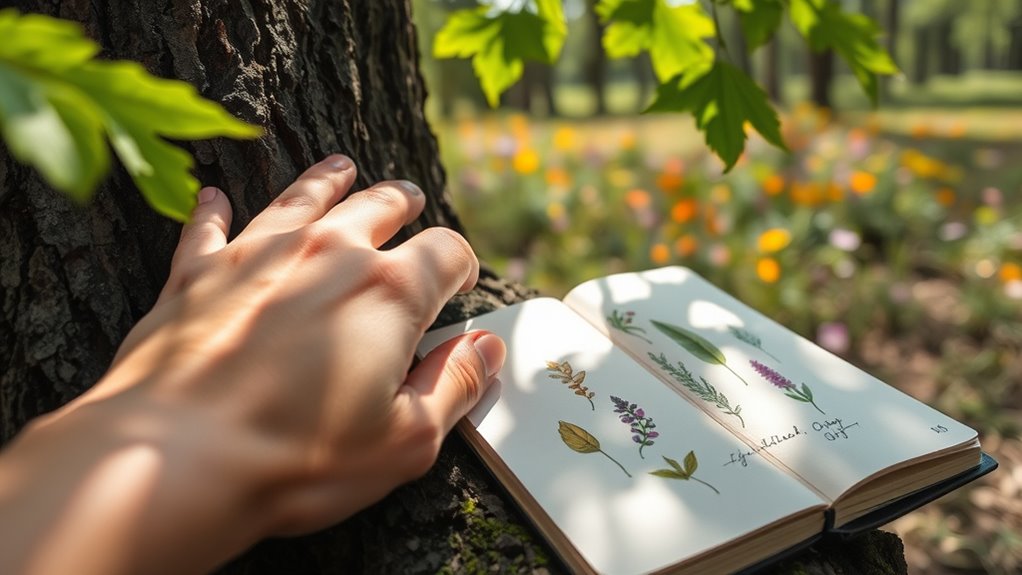
To truly immerse yourself in nature, actively engage your senses by consciously noticing the details around you. Practice sensory awareness by focusing on what you see, hear, touch, smell, and taste. Use mindful observation to deepen your connection with your environment. For example, pause and:
Immerse yourself in nature by consciously noticing sights, sounds, textures, and scents through mindful sensory awareness.
- Observe the intricate patterns on leaves or bark, feeling their textures.
- Listen intently to bird calls, rustling leaves, or flowing water.
- Smell the earth, flowers, or fresh foliage, noticing how scents shift with your movement.
- Recognize the variety of camping gear that can enhance your outdoor experience, making mindful exploration more comfortable and enjoyable.
Engaging your senses in this way heightens your awareness and enriches your experience. It encourages a present-focused mindset, allowing you to fully absorb the natural world around you. This practice turns a simple walk into a mindful exploration, fostering deeper connection and appreciation.
Prompts and Ideas for Meaningful Nature Entries
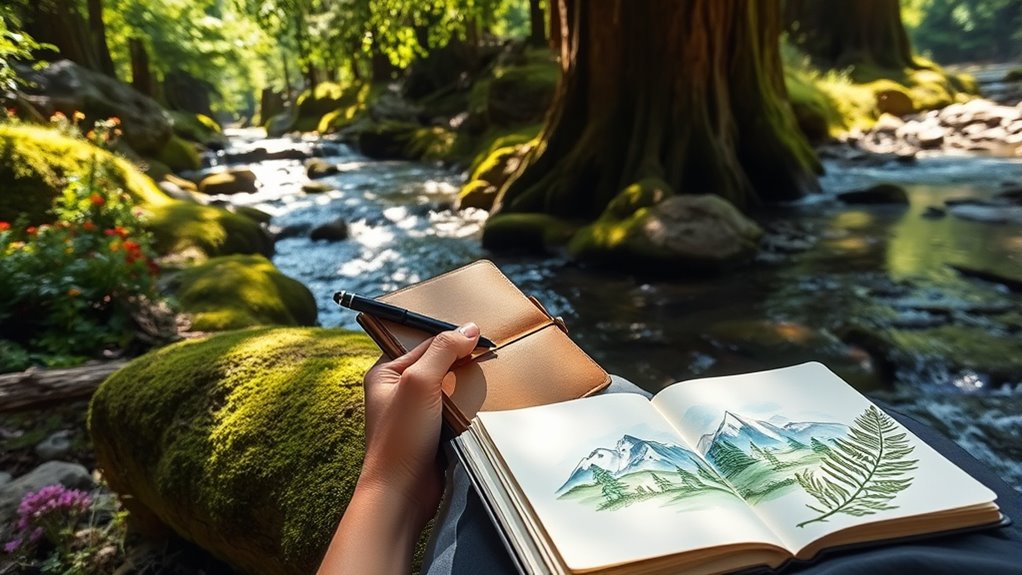
Finding meaningful ways to document your outdoor experiences can deepen your connection to nature and inspire reflection. Use prompts that encourage you to explore your surroundings creatively, such as writing nature-inspired poetry that captures the essence of a moment or scene. Try sketching botanical sketches of plants or flowers you encounter, focusing on their shapes and details. Ask yourself questions like, “What colors stand out today?” or “How does this place make me feel?” to guide your entries. These prompts help you slow down and observe more deeply. Incorporating poetry and sketches transforms your journaling into a personal reflection and artistic expression, fostering a stronger bond with nature and enriching your outdoor adventures. Additionally, understanding vetted supplies like durable, aesthetically pleasing notebooks or sketchbooks can enhance your journaling experience.
Incorporating Mindfulness Practices Into Your Journaling Routine
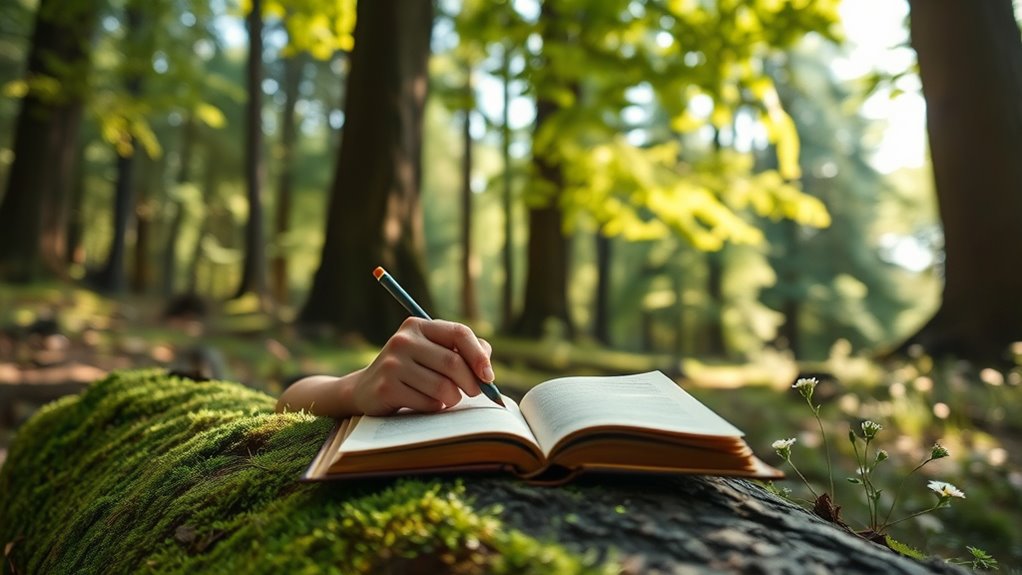
Incorporating mindfulness practices into your journaling routine can deepen your connection with nature and enhance your outdoor experiences. Start by practicing mindful breathing—pause periodically to focus on your breath, noticing each inhale and exhale. This helps ground you in the present moment. Implement a gratitude practice by noting what you’re thankful for during your hike or walk, fostering appreciation for your surroundings. To deepen your mindfulness, consider:
- Observing sensory details intentionally, like sounds or textures
- Taking slow, deliberate breaths before writing each entry
- Reflecting on moments of awe or wonder you encounter
These practices encourage a more engaged, reflective journaling process that nurtures your overall sense of connection and presence in nature. Additionally, paying attention to the color accuracy of your environment can enhance your perception and appreciation of natural scenery, making your journaling experience even more vivid and meaningful.
Reflecting on Your Experiences to Deepen Connection
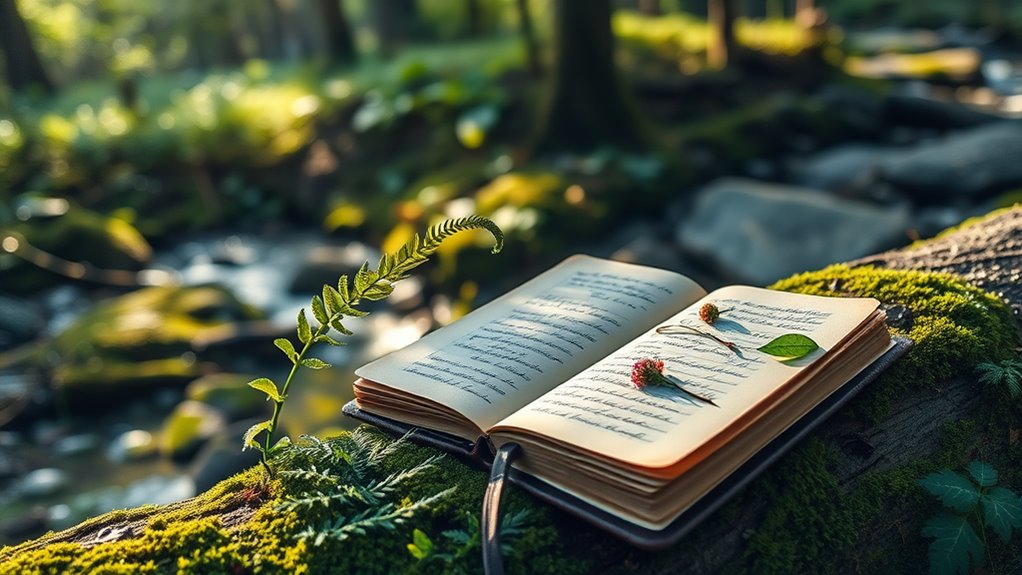
Reflecting on your experiences after each outing allows you to deepen your connection with nature. Take a moment to sit quietly and practice meditative breathing, grounding yourself in the present moment. As you breathe deeply, recall specific sights, sounds, and sensations from your walk, allowing those details to come alive on the page. Incorporate gratitude exercises by noting what you appreciated most—whether it’s a vibrant flower or a peaceful breeze. Writing about these moments helps reinforce your bond with nature and fosters a sense of appreciation. Engaging in mindfulness techniques during reflection can enhance your awareness and presence in the moment. Regular reflection transforms fleeting encounters into meaningful memories, encouraging mindfulness and a greater sense of wonder. Over time, this practice cultivates a heartfelt connection that enhances every future adventure outdoors.
Frequently Asked Questions
How Can I Start Journaling if I Feel Self-Conscious?
If you feel self-conscious about journaling, start small to build confidence. Embrace vulnerability by writing just a few lines each day or doodling your thoughts without judgment. Remember, it’s your personal space; no need to share immediately. Over time, you’ll become more comfortable expressing yourself. Focus on the process rather than perfection, and you’ll find journaling becomes a natural and rewarding way to connect with your feelings.
What Are Some Eco-Friendly Journaling Supplies?
Imagine your journal as a gentle stream, flowing with purpose and respect for nature. You can choose eco-friendly supplies like notebooks made from sustainable materials and pens filled with biodegradable inks. These choices help minimize your footprint while nurturing your connection to the Earth. By selecting environmentally conscious materials, you turn your journaling into a harmonious dance with nature, enriching your reflection and protecting the world you cherish.
How Do I Maintain Consistency in My Mindful Travel Journaling?
To stay consistent with your journaling, you should develop habit strategies like setting a specific time each day and creating a dedicated space. Find accountability partners, such as friends or fellow travelers, who can encourage you and share progress. You might also track your journaling streaks or reward yourself for meeting goals. These methods help you stay motivated and make journaling a natural part of your routine.
Can Digital Journaling Be Effective for Nature Connection?
Your digital creativity can turn virtual reflections into powerful tools for nature connection, proving that digital journaling is just as impactful as traditional methods. It’s not an overstatement to say that digital journaling can deepen your appreciation and awareness of nature, even amidst a busy schedule. With apps and multimedia options, you can capture sounds, images, and thoughts instantly, making your connection to nature more vivid and accessible wherever you are.
How Do I Handle Difficult Emotions That Arise During Journaling?
When difficult emotions arise during journaling, focus on emotional awareness by acknowledging what you’re feeling without judgment. Use coping strategies like deep breathing or pausing to process your emotions. Write freely to explore your feelings and gain clarity. Remember, it’s okay to take breaks or seek support if needed. This approach helps you navigate tough emotions and fosters a healthier, more mindful journaling practice.
Conclusion
Embracing mindful travel journaling can enhance your connection to nature and boost well-being. Did you know that practicing mindfulness can reduce stress by up to 30%? By dedicating time to reflect and engage your senses, you create a deeper bond with the natural world around you. So, pack your journal, stay present, and let each walk become a meaningful journey of discovery and inner peace. Your mindful exploration awaits—start today.










